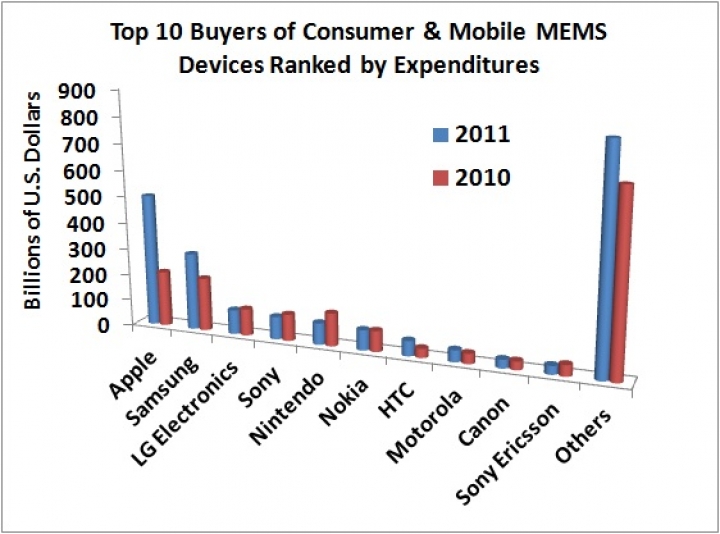Apple & Samsung Eclipse Mobile MEMS Market

Apple and Samsung Electronics remained the two largest buyers of microelectromechanical systems (MEMS) devices for consumer and mobile applications in 2011, solidifying their command and expanding their influence over the market, according to IHS iSuppli's latest MEMS Market Tracker report.
The two firms last year together accounted for 37 percent of the consumer and mobile MEMS space, mainly on the strength of their smartphones and tablets using MEMS devices like accelerometers, gyroscopes, MEMS microphones and bulk acoustic wave filters.
Apple, the top buyer, made MEMS purchases equivalent to $499.8 million, or roughly 23 percent, of the $2.1 billion consumer and mobile MEMS market. Samsung, in second place, was worth $291.3 million to the industry, or 14 percent. Apple's total last year was up 139 percent from $209.2 million in 2010, while Samsung's MEMS expenditure was up 45 percent from $201.2 million for the same period.
"The dominance of Apple and Samsung is due in to their successful smartphone and tablet offerings, which contrast dramatically with other Top 10 buyers who do not share the same level of success in either product offering or both," said Jérémie Bouchaud, director and senior principal analyst for MEMS & sensors at IHS.
"In the smartphone market, for instance, Apple's iPhone is a category killer, while Samsung's various smartphone models collectively enjoy massive share. Apple's lead in the tablet space is formidable given the unmatched dominance of the iPad. While Samsung's unit share of the tablet market still hovers around 10 percent, its success in the smartphone market coupled with its technological and marketing prowess position Samsung as one of the strongest potential challengers to Apple's long-term dominance in tablets."
With the overall consumer and mobile MEMS market continuing to grow because of smartphones and tablets, and given that both Apple and Samsung are the principal players in those product lines, the two companies are in no danger of seeing their influence wane for at least a few more years, IHS believes.
The size of both Apple and Samsung was such that none of the eight companies making up the top ten last year individually contributed more than $100 million to the overall consumer and mobile MEMS space. The rest of the top ten included LG Electronics, Sony, Nintendo, Nokia, HTC, Motorola, Canon and the now-dissolved Sony Ericsson.
The purchasing landscape for consumer and mobile MEMS changed with the arrival of mobile handsets - especially smartphones - and tablets. The two popular consumer electronics devices combined accounted for 60 percent in value of the consumer and mobile MEMS market in 2011, and their share is projected to reach an even higher 67 percent by 2016. In contrast to the new-found prominence of handsets and tablets, gaming is no longer as important compared to that segment's primacy in 2007, when Nintendo reigned as the top buyer for consumer and mobile MEMS.
Beyond influencing the market share of suppliers, Apple and Samsung have incredible purchasing and negotiating power. As a result, they can command different prices than the rest of the industry, with both companies paying significantly less for accelerometers and gyroscopes. The two companies currently spend 20 to 25 percent less on accelerometers than other handset makers, and 10 to 15 percent less on gyroscopes.
Such low prices are a hurdle for companies trying to win designs with the two giants. Failing that, MEMS suppliers do business instead with other manufacturers. In doing so, these suppliers are able to command better prices than if they dealt with Apple and Samsung, but choosing to supply other partners besides the two majors also means being resigned to much smaller sales volumes.
The combined weight of Apple and Samsung in the consumer and mobile MEMS market translates into palpable advantages for both. On the other hand, the MEMS suppliers must make concessions in order to accommodate the giants' heft.
For instance, suppliers know that they can only hope to win significant share by catering to at least one of the two behemoths. Otherwise, one contends with crumbs and is saddled with middling sales volumes unsuitable for large-scale market competition.
By all accounts, winning business from Samsung is easier than securing sales from Apple. Consistent with Samsung's approach to be many things to many people, Samsung uses multiple MEMS suppliers for the same handset platform. German firm, Bosch, French-Italian STMicroelectronics and New York-based Kionix all supply accelerometers to the South Korean electronics giant, while InvenSense from California and STMicroelectronics supply Samsung with gyroscopes. Illinois-based Knowles Electronics was the sole trusted supplier of MEMS microphone to Samsung for some time, but Goertek from China has made inroads into Samsung cellphones this year.
Supplying to Apple is more challenging. Until now, the firm has stayed loyal to STMicroelectronics for the supply of accelerometers and gyroscopes to the iPhone and iPad. Apple, in turn, accounted for roughly half of the MEMS sales of STMicroelectronics last year. There is no indication that Apple will switch suppliers anytime soon, even though other manufacturers have yearned to be let in. But Apple has also slightly widened its pool of suppliers in the last year or so. Already, it uses U.S. entity Knowles and AAC of China for MEMS microphones in the iPhone 4 and 4S; Analog Devices of Massachusetts for the iPod nano 5th as well as the iPad 2; and AAC again for the new iPad.
































